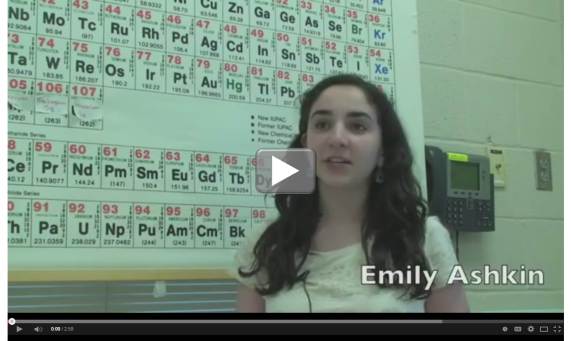Lessons from a High School Student: Motivation + Perseverance = Success
It may surprise you to learn that the poised young woman featured in this video was a sophomore in high school at the time the film was made. Today, Emily Ashkin is a high school senior with impressive laboratory experience and science awards to her name. As it happens, she’s also introducing me when I deliver a keynote address at the Melanoma Research Alliance’s annual scientific meeting — today, here in Washington, D.C.
What struck me most when I heard Emily’s story was her fearlessness. When mentoring young students, helping some to believe in themselves can be a real challenge. Not Emily. She faces her challenges by seeking solutions, asking—as she does in the video—“Why can’t that be me?”
In the video, Emily talks about getting inspired to channel her interests in science toward work on cancer. Picking up where the video leaves off, Emily continued as a volunteer in the lab of Pinku Mukherjee at the University of North Carolina at Charlotte. She switched from breast to pancreatic cancer and began studying MUC1, a glycoprotein tethered to the outer surface of the cell. MUC1 is overexpressed in about 60 percent of pancreatic cancers, a disease associated with an almost uniformly poor prognosis.
She entered the 2014 North Carolina International Science Challenge with a project involving MUC1. Emily used the glycoprotein as a biomarker to show that a common secreted signaling protein called TGF-β1 had switched from a growth inhibitor to a tumor promoter in pancreatic cancer. Her research earned a trip to China to represent the United States in the annual, international Beijing Student Science Competition. Emily brought home first place in the biochemistry competition and a wealth of wonderful experiences.
In the spring of 2014, Emily read a review article about cancer immunotherapy, a treatment that harnesses the power and specificity of a patient’s own immune system to target tumor cells. The article left her with questions—and so she wrote to the senior author, Patrick Hwu at M.D. Anderson Cancer Center in Houston. Hwu studies melanoma. An exchange followed and ultimately led to Emily’s invitation to work in Hwu’s lab that summer. There, she fell in love with Houston and M.D. Anderson.
Now 17, Emily will be graduating from high school, then returning to Hwu’s lab this summer and staying on in Houston to attend Rice University. She plans to major in biochemistry and cell biology, with a minor in Hindi. (“I love Bollywood films, and I don’t want to read the subtitles anymore,” she explained)
In the meantime, she’s one of 40 finalists in the prestigious Intel Science Talent Search. She’ll be presenting her project from M.D. Anderson, in which she searches for the right cancer drug to unmask melanoma cells hiding in the body and expose them to killer immune cells.
Here’s wishing Emily, and all of the finalists, success—and stellar, fearless careers in science.
Links:
Why Is Melanoma So Difficult to Treat? (Video interview with Patrick Hwu)
Melanoma (NCI/NIH)























.png)











No hay comentarios:
Publicar un comentario